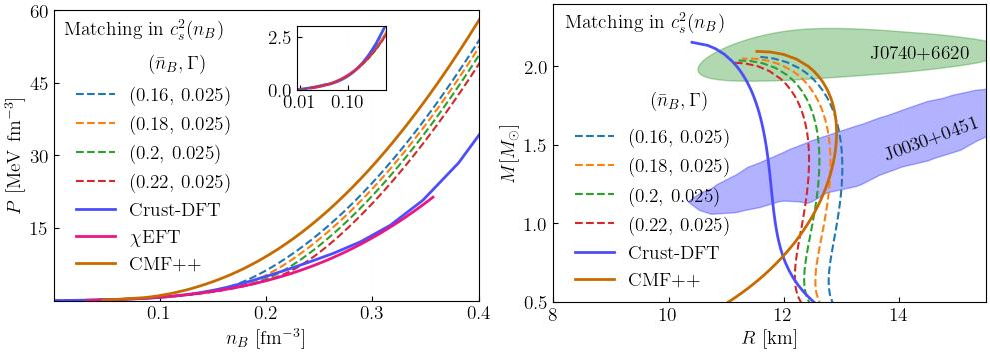Building Neutron Stars with the MUSES Calculation Engine

Exploring the Equation of State (EoS) of dense matter is an essential part of interpreting the observable properties of neutron stars. Our latest paper presents the first results for dense matter in the zero-temperature limit, generated by the first public release MUSES Calculation Engine (CE) -future releases are planned to expand the scope of available modules and their capabilities.
The CE is built to model the EoS across the QCD phase diagram, covering the environment inside neutron stars and also those found in heavy ion collisions. To this end, the CE includes a variety of relevant models, some are focused on astrophysical computations while others are dedicated to heavy-ion collisions. The composable, multi-module workflows, allowing the user to connect modules and easily compute physical observables and process data.
In this paper we focus on the neutron star EoS, and explore how different matching procedures using different thermodynamic variables affect neutron star properties, such as mass and radius, and universal relations. We combine three EoS modules:
- Crust Density Functional Theory, valid starting at low densities.
- Chiral Effective Field Theory, valid around saturation density.
- Chiral Mean Field model, valid beyond saturation density.
We create the workflows using, in addition to the EoS modules, the Lepton module to ensure charge neutrality and beta-equilibrium; the Synthesis module, to match the three equations of state using different thermodynamic variables and different methods; and the QLIMR module, a novel full-general-relativity solver, that calculates neutron star properties.
Moreover, we use the Flavor Equilibration module to estimate bulk viscosity and flavor relaxation charge fraction and rates (at low temperature) for Chiral Effective Field Theory and the Chiral Mean Field model.
Our investigation highlights how the choice of the matching variable can influence the resulting EoS and, consequently, the astrophysical observables. While naive matching of EoSs might introduce artificial features such as unphysical structures in the speed of sound or large artificial first-order phase transitions, we used methods that either remove or keep to a minimum such artificial features. This allows us to devise thermodynamically consistent crust-to-core EoSs. In Fig. 1 we show the matched EoS in the speed of sound squared as a function of the baryon density, the original ones and their respective mass-radius curves.
We find that the radii of neutron stars are the most affected observable, with a total variation of ΔR* 1.4 M⊙=9.21% when considering all matching methods. The maximum mass, on the other hand, has a variation of 3.73%. Additionally, the universal I-Love-Q relations remain robust.
The release of the CE lays the groundwork for future studies where nuclear theorists, gravitational-wave physicists, astrophysicists, and experimentalists can directly sample nuclear physics parameters. Instead of relying solely on phenomenological toy models, researchers will soon be able to constrain the EoS using combined observational data from gravitational waves, X-ray emissions, and heavy-ion collisions.
All the code used in this work is public, and it can be found at our Zenodo community. The Calculation Engine website can be accessed here: https://ce.musesframework.io/.
Title
Building Neutron Stars with the MUSES Calculation Engine
Authors
Mateus Reinke Pelicer, Nikolas Cruz-Camacho, Carlos Conde-Ocazionez, David Friedenberg, Satyajit Roy, Ziyuan Zhang, T. Andrew Manning, Mark G. Alford, Alexander Clevinger, Joaquin Grefa, Roland Haas, Alexander Haber, Mauricio Hippert, Jeremy W. Holt, Johannes Jahan, Micheal Kahangirwe, Rajesh Kumar, Jeffrey Peterson, Hitansh Shah, Andrew W. Steiner, Hung Tan, Yumu Yang, Volodymyr Vovchenko, Veronica Dexheimer, Jorge Noronha, Jaquelyn Noronha-Hostler, Claudia Ratti, Nicolás Yunes
Abstract
Exploring the equation of state of dense matter is an essential part of interpreting the observable properties of neutron stars. We present here the first results for dense matter in the zero-temperature limit generated by the MUSES Calculation Engine, a composable workflow management system that orchestrates calculation and data processing stages comprising a collection of software modules designed within the MUSES framework.
The modules presented in this work calculate equations of state using algorithms spanning three different theories/models: (1) Crust Density Functional Theory, valid starting at low densities, (2) Chiral Effective Field Theory, valid around saturation density, and (3) the Chiral Mean Field model, valid beyond saturation density.
Lepton contributions are added through the Lepton module to each equation of state, ensuring charge neutrality and the possibility of β-equilibrium.
Using the Synthesis module, we match the three equations of state using different thermodynamic variables and different methods. We then couple the complete equation of state to a novel full-general-relativity solver (QLIMR) module that calculates neutron star properties.
We find that the matching performed using different thermodynamic variables affects differently the range obtained for neutron star masses and radii (although never beyond a few percent difference). We also investigate the universality of equation of state-independent relations for our matched stars. Finally, for the first time, we use the Flavor Equilibration module to estimate bulk viscosity and flavor relaxation charge fraction and rates (at low temperature) for Chiral Effective Field Theory and the Chiral Mean Field model.
BibTeX
@article{ReinkePelicer:2025vuh,
author = "Reinke Pelicer, Mateus and others",
title = "{Building Neutron Stars with the MUSES Calculation Engine}",
eprint = "2502.07902",
archivePrefix = "arXiv",
primaryClass = "nucl-th",
month = "2",
year = "2025" }


